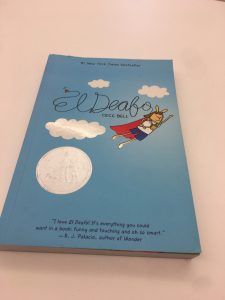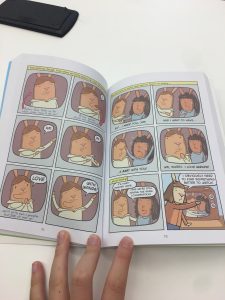Title: El Deafo
Author(s ): Cece Bell
Illustrator/Photographer: Cece Bell
Publisher and Year: Amulet Books, 2014
Number of pages: 233
Tags/Themes: Allison Henry, Animals, Award Book, Fiction, 4-5, 6-8, Family, Graphic Novel
Genre: Realistic Fiction
Descriptive Annotation: El Deafo is the story of a young girl, Cece, navigating elementary school and all that entails, while deaf. After contracting meningitis at age 4, Cece loses all ability to hear. She receives hearing aids and a Phonic Ear to use in school. In order to cope with being different, Cece creates an alter-ego, El Deafo. This book is a graphic novel, therefore there are many illustrations in the text. Students would need to have background knowledge in basic school situations, a middle to upper elementary level vocabulary, and the knowledge of how to read a graphic novel.
Classroom Application: I would use this text to address the Social Emotional Learning Standards for late elementary. This book could be used for Learning Standards 1.A., 2.A., 2.B.2.b., 2.C., and 2.D. These standards refer to explaining emotions, identifying social clues and describing them, identifying differences and overcoming them, and cooperating with friends and other groups. All of these topics are addressed in El Deafo, where the situations are presented, Cece chooses a course of action, and then the consequences are shown.
Linguistic and Cultural Diversity Analysis: This book is about a child that is deaf. This story presents many situations that students that are deaf and their classmates could find themselves in. This book could be used to start a discussion about treatment of peers that may be different from themselves. This book was published in 2014, therefore it is up to date in the vocabulary that it uses to describe the situations and the treatments used to assist the student that is deaf. This book could be introduced by explaining to the students that sometimes, people have different abilities. It could also be explained that, just because someone may have different abilities, does not mean that they are in need of assistance. It can be used to start a discussion on appropriate treatment of peers, addressing both bullying and trying to be too helpful. On page 34, Cece is teased by a friend for mishearing a question. Her friend, Emma, says, “No-not supper-summer! Summmmmm-mmmmmer! Supper! HEE HEE!” This part of the story focuses on Cece being teased by her peers and how see feels when this happens. Later in the story, Cece makes a friend that is too helpful. In response to Ginny, her friend, saying, “CEE-CEE. DOO YOO WANT MYYY PEEA-NUT BUTT-ER SAND-WICH?”, Cece thinks, “I really, really like Ginny. She’s funny. She’s weird. We love all the same things. So what’s the problem? It’s the wat she talks to me… “(67).


